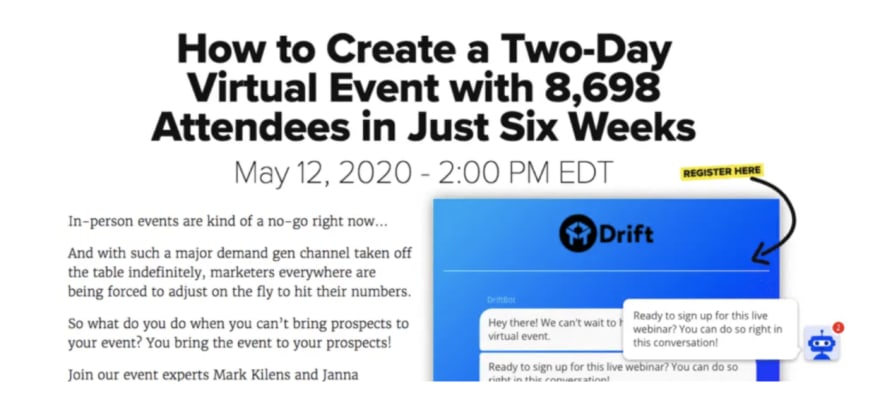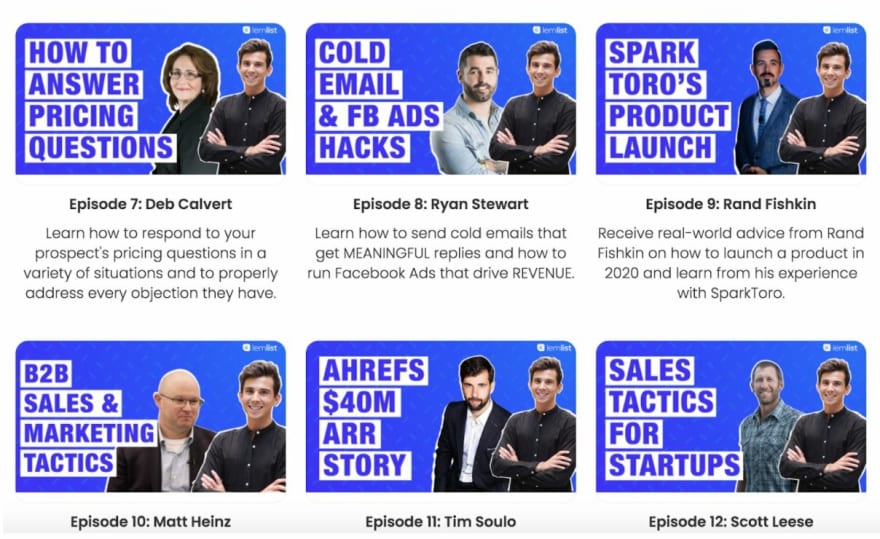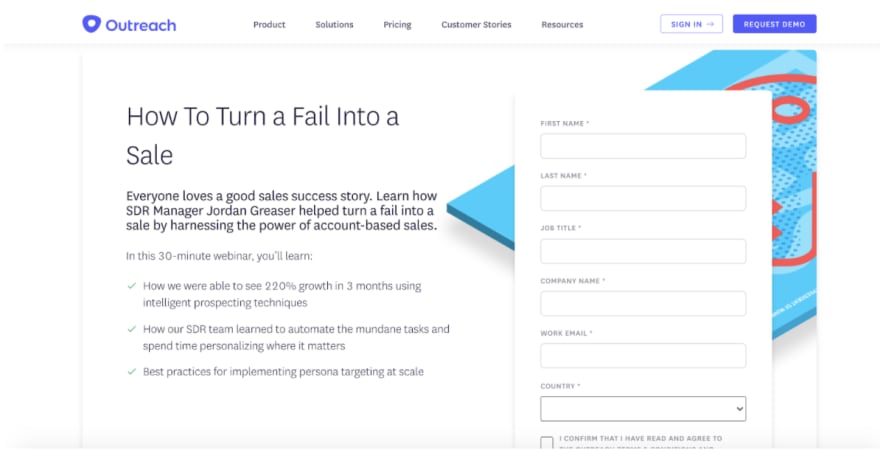In most online resources that will teach you how to conduct successful webinars, you will most likely get generic tips on setting up landing pages, choosing webinar software, and promoting it on social channels.
Having conducted dozens of webinars that turned out to be both successes and failures, I have learned that one can succeed with webinars only through practice – by making mistakes and improving with every live transmission.
Let’s face it – anyone can set up a virtual room and read a presentation. The truth is when you know the basics and do everything according to the book, you can still fail. Why? The devil is in the details.
In this article, I will share my key learnings from organizing the webinars, which helped attract the right highly-engaged audience. No matter if you decide to run webinars on your own or hire a marketer to help you during this process — in both cases, you will acquire the right mindset to help you conduct successful webinars.
How to generate more leads with webinars
Let’s dive deeper into eight tips to organize and successfully promote webinars that gather a full room of highly targeted prospects. These are the boxes you need to tick before you go live.
1. Choose the right topic
Even though choosing the right topic seems to be the most obvious thing on Earth when it comes to webinars, you can make the most mistakes with this one.
When choosing the topic for your webinar, avoid general descriptive topics that don’t address these two points:
- Eliminate pain
- Help achieve the desired outcome In other words, your webinar topic should either be a pain killer or a vitamin.
Let’s take a look at the webinar case study of Drift, a company famous for using chatbot marketing hacks for lead generation. It’s clear what the webinar helps achieve. Also, it’s quite specific.
Bringing up a unique case study in the headline is what makes this webinar valuable! Incorporating case studies and numbers in your topic makes it much easier for you to convince prospects to sign up for it during the stage of webinar promotion.
Protip: you can also tweak the topic to repel your “negative persona” or people who will never become your customers. Make sure you clearly state who the webinar is for and who won’t derive value from it.
For example, by stating the webinar is for SaaS growth consultants, you would turn away junior marketing people. Make sure you have aligned the benefits of the webinar with your persona’s personal and professional goals.
2. Co-host with industry influencers
Even though your company might not have a recognizable brand just yet, you can enhance your image by inviting industry thought leaders who have already built a reputation.
Check out how Lemlist, an outreach tool, does it with sales and marketing heroes. They have hosted a series of webinars with sales and growth marketing experts that went viral.
Do your research online to find influencers in your field who have a well-developed and engaged social media network.
Find out how popular their materials are by looking into engagement metrics such as comments, likes, and reposts. Check out the popularity of their Youtube channels and page traffic to find out if they have built a sufficient legacy in their field.
Before you hit a message to an influencer, think carefully about what you can offer in return. For example, you could create a video that you could post on your closed group or promote with Facebook ads – this will help an influencer reach a new audience.
By creating a win-win situation you will be able to get even more recognizable people to join you every time you conduct the next webinar.
3. Design landing page copy
Before you start choosing your webinar software and setting up a virtual room, try to be as precise with your webinar value proposition as possible. If you are targeting your content at the B2B segment you should know how busy the decision-makers are and how little time you have to convince them.
Show real benefits and explain the reasons why someone would spend an hour of their time to watch your live transmission.
Perhaps this makes sense as you have managed to invite an “industry celebrity” that can share their secret sauce and their latest case studies or it may also be your know-how on solving specific problems.
Make sure you write concise and easy to understand sentences one can skim fast online. Use bullet points and icons to support your statements visually.
4. Optimize your signup form
Even if your topic and value proposition for the webinar is great, your landing page and signup form might underperform resulting in lost leads.
Here are some of the most common issues.
1) Sign up form contains a lot of fields
Don’t overwhelm your users – make your sign-up form simple and short. Ask for basic information – you can always collect more information about their profiles later on.
Let’s examine the form placed on the webinar page of Outreach. One – it is annoying to fill in all the fields. Two – let’s be honest: would you provide all the correct information? On the contrary, you may still decide to randomly fill it in just to get a sign-up link. So what’s the point?
Consider collecting as little information about your leads as possible to make it easier to sign up. You can even sign up your contact using a chatbot and don’t need to have a complex sign up system.
2) Your sign up form doesn’t work properly
Perhaps, there is some bug which causes problems on sign up. First, check out the process on different browsers by yourself or use special testing tools. Next, install heatmaps and track user interaction with the forms to identify issues. Keep an eye on mobile performance as well – your form might look differently on smaller devices.
3) Your sign up form is not intuitive
Make sure you provide a user with clear guidance on what information needs to be filled in and where. Sometimes, users don’t know what’s wrong as a warning message is not displayed correctly. That is why you have to test your forms by yourself or some test users and work on eliminating critical form usability issues.
5. Book at least 1 month for promotion
Setting up a landing page and choosing the most optimal webinar platform is not rocket science. When organizational aspects of the webinar make 20% of work, 80% of effort needs to be dedicated to promotion.
Make sure you have planned for at least 3-4 weeks of promotion prior to the webinar. For this, you have to calculate how many leads you are planning to generate, define channels, and allocate budget to each of them respectively.
Here are just some ideas for you to incorporate into your webinar promotion strategy.
*Use social media management tools to schedule posts prior to the webinar.
*Consider incorporating video marketing into your promotional activities.
- Design and send email newsletters to your subscribers.
- Set up website popups.
- Launch paid ads.
Track progress every week to know if you are on track with your lead targets. If you have already dealt with webinar promotion before, you can benchmark against historical data on lead generation and marketing costs.
Don’t leave promotion for the last week if you want your effort to pay off in leads and sales!
6. Get co-hosts to promote
Apart from spending money on paid channels, you can also engage your guests in the promotion process. Ask if they can schedule a social media post to promote your webinar. Encourage them to promote your webinar on their channels, send newsletters, and post on their groups.
Stress out that your webinar is a win-win game and your influencers can use your online event as a tool to nurture their leads as well.
By inviting their potential clients to the webinar, they also boost awareness about themselves and can use it as another sales touchpoint.
However, don’t be overbearing with your requests. Make co-promotion optional for your guests. Also, if you have chosen the right thought leaders and built trust with them prior to the webinar, you can be sure they won’t leave you alone with promotion.
That’s also just a simple physiological mechanism! They will love to brag about the fact someone has invited them to the webinar as an expert unless they are extremely high-caliber speakers who get hundreds of such invitations every month.
7. Engage leads before the webinar
Even though you might set up the target for the number of leads you want to generate, you should also define the turn-up rate as a key metric.
The more leads you manage to attract to the webinar, the more chances you have to build awareness about your brand’s expertise and convince them to buy your products. That is why you have to engage your leads prior to the webinar.
Set up automatic reminders on the day and 15 minutes before the event. Apart from sending an email with a reminder, you can also consider using SMS marketing and send SMS reminders if you have collected phone numbers through your sign up form.
Consider creating drip sequences that would educate your audience on the webinar topic before they join a live transmission. You can decide to send them one email weekly before the webinar or come up with another frequency. Don’t sell anything in your emails – make them educational and highly valuable for your audiences.
8. Nurture leads after the webinar
Create some special offers for your users and place them on the webinar replay page. You can consider including your product reviews there as well as it will provide an additional boost to your attendees’ confidence in buying your product. Remember that 9 out of 10 customers read reviews before they end up buying a product.
Don’t forget to set up post-webinar email sequences as a part of your sales automation strategy. The sequences should continue educating a user on the topic after the webinar is over.
Remember that webinars take some time to convert. That is why you have to not only retarget users with your company case studies and your client’s success stories to build trust with your company but also use other marketing channels to reach them.
For example, apart from email follow-ups, you can also consider adding a webinar attendee on LinkedIn. Engage them in a conversation and continue to build relationships to be top of mind.
Don’t be afraid to create multiple touchpoints with your leads for a better result.
According to some studies, one needs eight touch points, on average, to make a proposal and close the deal.
Wrap up
The best way to learn how to conduct successful webinars is to practice supported by smart tools. That is why I encourage you to start applying these tips in practice, understand what channels drive the most sign-ups and conversion, and invest in them more during the consequent online events. This way you will be able to achieve better results with each live session. Good luck!










Top comments (0)